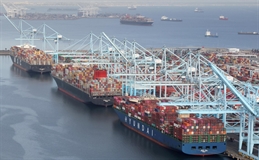
January proved to be a "dramatic month" for long-term ocean freight rates, according to the latest data from the Xeneta Shipping Index (XSI®), showing the largest ever month-on-month declines.
According to the XSI® — which is based on crowd-sourced data from leading shippers worldwide — average long-term contracted rates dropped by 13.3% in January.
Fifth month of rate decline
Xeneta said this is now the fifth month in a row of falling prices on the index, with, as it warns, little sign of change ahead in what looks set to be a challenging year for carriers.
January's decline marks a significant change in tempo from December's 0.1% dip in prices, but, as Xeneta CEO Patrik Berglund explains, it wasn't entirely unexpected.
"Global demand has fallen away, congestion has eased, equipment is available, and the macro-economic and geopolitical situations are, to say the least, complex," Berglund said.
"As a result of those market fundamentals, spot prices have collapsed, spiralling downwards since late summer 2022. However, the carriers have managed to protect long-term rates from the worst impacts until now."
The Xeneta chief noted that with the dawn of 2023, many of the contracts negotiated last year have expired.
"Shippers, well aware of market dynamics turning in their favour, have reacted, pushing carriers for major rate reductions. What we're seeing now is the effect of that as new contracts enter validity. And, for the carriers, worse is set to come," Berglund added.
Overcapacity looms large
Berglund further notes that May last year saw the XSI®'s largest monthly increase in a "super-hot" market, with a climb of 30.1%.
He said US import rates soared a staggering 65%. With contracts negotiated and then set to expire at the end of April, upcoming falls could again rewrite the record books.
"January has been difficult for the carriers, and there's a real danger of some horrific times on the horizon," he said.
"With the market looking so depressed, overcapacity seems certain to loom large throughout the year. The only hope of protecting rates is removing capacity at a pace that mirrors demand, or rather the lack of it."
"It's been a golden age for carriers since the pandemic wreaked havoc on global supply chains, but the tide has well and truly turned," Berglund added.
The Xeneta report said all six of the XSI®'s regional sub-indexes posted drops in January, some of which are the largest on record.
January's largest fall was recorded on the Far East export subindex, with this major fronthaul corridor losing 18.1% of its value (41% up year-on-year). However, the backhaul proved more resilient, posting a 3.2% fall on the import benchmark – although this is still the sub-index with the smallest year-on-year increase, up 25.7%.
In Europe, the import benchmark saw a 9.6% drop, with Xeneta noting some even larger declines associated with the trade from the Far East. The average valid long-term rate from the Far East to North Europe fell by 17%, with those from the Far East to the Mediterranean slipping by 15%.
However, it added that despite these sharp falls, the previous strength of the market means rates remain 40.9% up year-on-year.
The XSI® for exports also sits strong, despite a 5.2% fall this month, up a commanding 83% against January 2022.
"The story is similar in the US across January, with the import subindex declining 15.8% from December. The export benchmark performed better in the soft market, with 'only' a 1.3% month-on-month drop," the report further said.
Not yet a "panic" situation
"From a short-term perspective, these figures are steeped in a sense of doom and gloom for the carrier community, but that's far from the whole story," Berglund concludes.
"If we look back to this time last year, the Global XSI is currently a remarkable 52.7% up. But if we cast our vision a little further back still – to January 2020, before the pandemic – then we can see an increase in long-term contract rates of a genuinely staggering 216.4%."
"I don't think anyone could have predicted that scale of change," he added.
"So, yes, rates are dropping, but they have been climbing for a very long time. So, it's not panic stations just yet… But it might be in the months to come."



